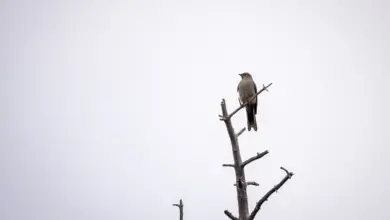Amazonian Oropendolas
The Amazonian Oropendolas (Psarocolius bifasciatus) is both the largest member of the Icterid family and the largest passerine bird in South America.
Distribution / Range
This species is found widely – but often in low densities – throughout humid lowland forests of the Amazon Basin, with the notable exception of most of the Guiana Shield.
It is sometimes split into two species:
- the western Olive Oropendola (P. yuracares) and
- the eastern Pará Oropendola (P. bifasciatus)
The subspecies P. y. naive is widely recognized as a hybrid swarm (= hybrid between different subspecies), and the vast majority of authorities consider them a single species.
Description
The sexes of this icterid are very different in size: the male is 52 cm (21 in) long and weighs 550 g (1.2 lbs); the smaller female is 41 cm (16 in) long and weighs 260 g (9.2 oz).
Confusingly, the name “Olive Oropendola” has sometimes been used for this combined species, even though the nominate subspecies has no olive to its plumage, as its head and chest are black (these are olive in P. b. yuracares).
The back, wings, and belly of this large oropendola are brown, the outer rectrices (the long flight feathers of the tail) are yellow (i.e. tail appears all yellow from below), the bare facial skin is pink, the eyes are brown, and the bill is black with an orange tip.
The superficially similar Green Oropendola has an olive back and wing coverts, lacks extensive bare facial skin, has a pale bill with an orange tip, and blue eyes.
Behavior
The Amazonian Oropendolas is a canopy bird that most often is seen flying high over the tops of trees. Compared to other oropendolas it is a “loner” most frequently seen alone or in pairs, and drawing less attention to itself than its cousins, despite the greater size.
Small groups are seen occasionally, and may even mix with other oropendolas. The breeding colonies are small, usually with fewer than 5 birds.
The nest is a hanging woven ball of fibres and vines, 60–180 cm long, high in a tree. Due to their inconspicuous nature, relatively little is known about these bird’s breeding habits.
hey often travel great distances through the forests, except when lingering around their nesting colony.
Diet / Feeding
The omnivorous diet appears to be fairly catholic, with small vertebrates, large insects, amphibians, reptiles, nectar, and fruit.
Calls / Vocalizations
The song of the Amazonian Oropendolas is described as a liquid, gurgling, and “expanding” stek-ek-ek-ek-eh-eh-eh-o’o ‘GLOOP!, given as a displaying male falls forward on a perch and rustles his wings over the back.
In flight or when foraging, nasal raap, and whrup calls can be heard.




